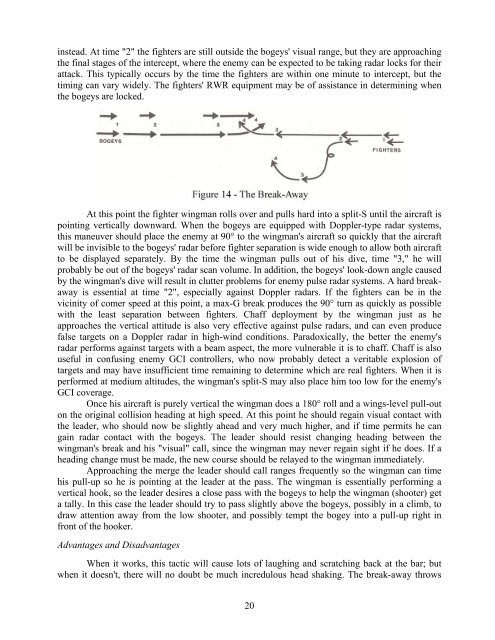Tactical Intercepts.pdf - e-HAF
Tactical Intercepts.pdf - e-HAF
Tactical Intercepts.pdf - e-HAF
Create successful ePaper yourself
Turn your PDF publications into a flip-book with our unique Google optimized e-Paper software.
instead. At time "2" the fighters are still outside the bogeys' visual range, but they are approaching<br />
the final stages of the intercept, where the enemy can be expected to be taking radar locks for their<br />
attack. This typically occurs by the time the fighters are within one minute to intercept, but the<br />
timing can vary widely. The fighters' RWR equipment may be of assistance in determining when<br />
the bogeys are locked.<br />
At this point the fighter wingman rolls over and pulls hard into a split-S until the aircraft is<br />
pointing vertically downward. When the bogeys are equipped with Doppler-type radar systems,<br />
this maneuver should place the enemy at 90° to the wingman's aircraft so quickly that the aircraft<br />
will be invisible to the bogeys' radar before fighter separation is wide enough to allow both aircraft<br />
to be displayed separately. By the time the wingman pulls out of his dive, time "3," he will<br />
probably be out of the bogeys' radar scan volume. In addition, the bogeys' look-down angle caused<br />
by the wingman's dive will result in clutter problems for enemy pulse radar systems. A hard breakaway<br />
is essential at time "2", especially against Doppler radars. If the fighters can be in the<br />
vicinity of comer speed at this point, a max-G break produces the 90° turn as quickly as possible<br />
with the least separation between fighters. Chaff deployment by the wingman just as he<br />
approaches the vertical attitude is also very effective against pulse radars, and can even produce<br />
false targets on a Doppler radar in high-wind conditions. Paradoxically, the better the enemy's<br />
radar performs against targets with a beam aspect, the more vulnerable it is to chaff. Chaff is also<br />
useful in confusing enemy GCI controllers, who now probably detect a veritable explosion of<br />
targets and may have insufficient time remaining to determine which are real fighters. When it is<br />
performed at medium altitudes, the wingman's split-S may also place him too low for the enemy's<br />
GCI coverage.<br />
Once his aircraft is purely vertical the wingman does a 180° roll and a wings-level pull-out<br />
on the original collision heading at high speed. At this point he should regain visual contact with<br />
the leader, who should now be slightly ahead and very much higher, and if time permits he can<br />
gain radar contact with the bogeys. The leader should resist changing heading between the<br />
wingman's break and his "visual" call, since the wingman may never regain sight if he does. If a<br />
heading change must be made, the new course should be relayed to the wingman immediately.<br />
Approaching the merge the leader should call ranges frequently so the wingman can time<br />
his pull-up so he is pointing at the leader at the pass. The wingman is essentially performing a<br />
vertical hook, so the leader desires a close pass with the bogeys to help the wingman (shooter) get<br />
a tally. In this case the leader should try to pass slightly above the bogeys, possibly in a climb, to<br />
draw attention away from the low shooter, and possibly tempt the bogey into a pull-up right in<br />
front of the hooker.<br />
Advantages and Disadvantages<br />
When it works, this tactic will cause lots of laughing and scratching back at the bar; but<br />
when it doesn't, there will no doubt be much incredulous head shaking. The break-away throws<br />
20
















